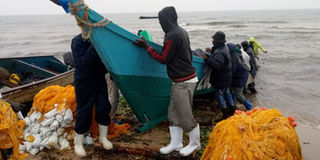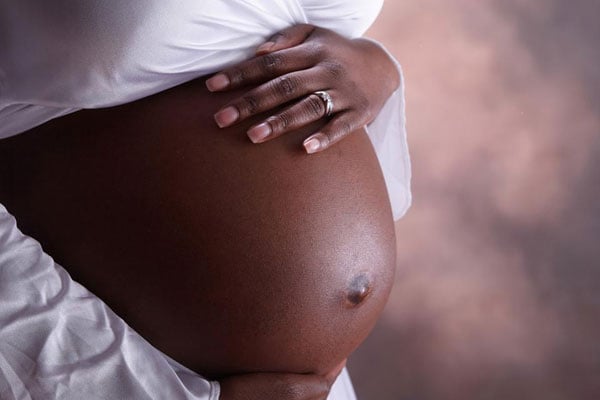Tough rules pushing out Kyotera fishermen

Livelihood. Fishermen dock at Kasensero Landing Site in Kyotera District last weekend. PHOTO BY IVAN KIMBOWA
What you need to know:
- The swim bladder has ready market in countries such as China and India and it is used to make bio-degradable surgical sutures.
- In January 2017, President Museveni established the Fisheries Protection Unit(FPU) to crackdown on illegal fishing on Ugandan water bodies which was blamed for the dwindling fish stock in the country.
Kyotera. Stringent regulations are slowly pushing fishermen out of business at Kasensero Landing Site in Kyotera District.
Previously, the fishermen could cast their nets and hooks on the shoreline and easily catch fish even during bad seasons.
“As more fishermen started flocking the lake, fish stocks also started declining. A big number of fishermen started using small-sized and electric nets which are also considered to be illegal prompting government to fight the vice,” Mr Peter Kali, a boat owner, says.
Among the new fishing guidelines, boat owners are required to have fishing gear, Tax Identification Numbers and National Identity Cards.
Boat owners, who are not fishermen, also need fishing licences for their workers, with each costing Shs25,000.
Registered fishermen are supposed to catch fish of more than 20 inches which weighs more than five kilogrammes.
“The regulations have increased the number of mature fish, but the expenses we incur while fishing are too high and the returns are very low,” Mr Kali says.
He says since the abolition of small boats, buying and maintaining a boat has become more expensive.
Mr Elias Frolian, a boat maker, says a recommended finishing boat is currently sold at between Sh3m and Shs4m before buying an engine, which ranges from Shs7m and Shs9m depending on the size.
“An ordinary fisherman today cannot afford that money and many have been pushed out of business. Sometimes, we make boats and spend months without getting any buyer, which was not the case before,” he says. Mr Frolian says there are seasons when they catch little or no fish.
“It is not acceptable to set nets or hooks on the shoreline, we have to go deep in waters. This requires fuelling the boat with between 20 and 35 litres. Sometimes, some boats come back without fish, but still you will have to motivate workers using the little gains collected from other boats,” he says.
Owners have to ensure that their boats are fully registered before embarking on a fishing expedition.
They usually hire two registered fishermen to operate each boat that uses nets, while those using hooks are normally three or four. They are paid according to the volume of fish caught.
“For those using nets, they are given two fish of every 10 caught while those with hooks after selling the fish, the boat owner gives them a portion of the profits,” Mr Johnson Wasswa, a fisherman, says.
Once they (fishermen working on boats) fail to catch any fish, Mr Wasswa says they go home empty-handed.
Most fishermen catch Nile perch, tilapia and silverfish. Although the fishing season is from March to October, fish are caught all year around.
“When the moon is full, sometimes we spend two to four days without catching fish. The situation has taught many fishermen how to save some money to help them during hard times. When it becomes worse, our bosses extend a hand to us and sometimes we borrow from them,” Mr Wasswa says.
There are always other workers waiting on the shoreline to clean and dry the nets after fishing.
“These are also paid Shs5,000 for a complete full fishing net which contains 30 nets tied up together. Engines are also removed for servicing and this also requires money,” he adds.
Mr Geoffrey Lutaaya, 23, who repairs engines at the Kasensero, says boats whose fishermen use nets are always serviced monthly while those who use hooks usually spend four days on water and each boat is charged between Shs20,000 to Shs40,000 for servicing.
Despite these costs, many boat owners and fishermen cannot quit the trade because it is their only means of survival.
Mr Julius Kafeero, 47, who abandoned farming to engage in fishing, says he still has hope that one day market prices will stabilise as fish stocks also increase.
“Sometimes we incur costs for three boats to go for fishing and collect fish weighing 300 kilogrammes, and the following day, we get nothing, but we must persist because that is how our business operates,” he says
Mr Abdul Ssenkima, the head of the fisheries department at Kasensero, confirms that there is a fall in fish prices today compared to the past three years.
“A kilogramme of Nile Perch used to be sold at between Shs10,000 and Shs12,000, but now it costs Shs5,000 and doesn’t go beyond Shs7,000,” Mr Ssenkima says. He urges government to determine the market prices.
The most type of fish trapped at Kasensero is the Nile perch which turned the most expensive type due to its swim bladder.
The swim bladder has ready market in countries such as China and India and it is used to make bio-degradable surgical sutures.
It is also used in the preparation of salmon style slices, soup concrete, fish sausages, fish cutlets and hams.
The Nile perch bones are used in making ornament while the skin is used in making shoes and handbags.
Background
In January 2017, President Museveni established the Fisheries Protection Unit(FPU) to crackdown on illegal fishing on Ugandan water bodies which was blamed for the dwindling fish stock in the country. However, soldiers under FPU have on several occasions been criticised over their high-handedness in dealing with people suspected of engaging in illegal fishing. During FPU operations, many people suspected to dealing in immature fish have been arrested and several ungazetted landing sites destroyed along the shores of Lake Victoria, Kyoga and Lake Albert .
Ministry of Agriculture records show that Uganda has a fish capture potential of 750,000 tonnes annually; the current production is at 461,000 tonnes and 100,000 tonnes from aquaculture. There are 250 species of fish in the country’s major lakes of Victoria, Kyoga, Albert, George, Edward and more than 160 in minor lakes.




